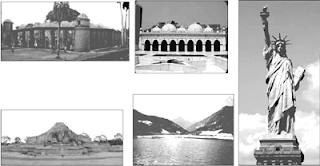A. Look at the picture and talk about it in pairs.
1 Do you know what it is?
2 Discuss what stands out in the picture.
3 Do you think it is a man or a woman?
B. Read the questions first Now listen to the Audio about the Statue of Liberty and answer the following questions.
Listening text 7
1 Where is the Statue of Liberty situated?
2 Which country gave the statue as a gift?
3 The gift was meant for which country?
4 On what occasion was it given?
5 When was the statue given?
6 What does the statue represent?
C. Listen to the text again and complete the chart.
Statue of
Liberty
|
Information
|
situated
|
|
artist
|
|
gift from
|
|
reason for the gift
|
|
presented on
|
|
occasion
|
|
the starue symbolizes
|
|
framework made of
|
|
amount of copper used
|
|
weight
|
|
year it was declared a UNESCO World
|
|
Heritage Site
|
D. Read the text and answer the following questions.
The French sculptor Frederic Auguste Bartholdi was assigned to design and complete a sculpture Liberty Enlightening the World within 1876, so that it could be a gift for the Americans on the occasion of the hundredth anniversary of the American Declaration of Independence. The statue was a joint venture between the USA and France. The French people would build the statue and assemble it in the States, and the people of the USA were to build the pedestal for the statue.
Raising money for the pedestal was completed in August 1885. The construction of the pedestal was finished in April 1886. In the meantime, France completed the Statue in July 1884. They sent it to New York on board the French war ship 'Isere' in 1885. While transporting the statue, it was split up into 350 pieces and packed in 214 crates.
It took four months to put the Statue together and place it on the pedestal. Thousands of people saw the unveiling ceremony of the Statue of Liberty on 28 October 1886. It was a centennial gift ten years late.
The Freedom that the Statue stands for is not stationary. The broken chain wrapped around her feet, sticking out from the bottom of her robe, symbolizes her free forward movement, enlightening the world with her torch, free from oppression and slavery.
The Statue's original torch was the first part constructed in 1876. It was replaced by a new copper torch covered in 24K gold leaf in 1984. The torch is lighted by flood light at night. The original torch is currently located in the lobby of the monument. Access to the torch has been closed since 1916.
From 28 October 2011, on her 125th anniversary, the Statue of Liberty was also named "Liberty Enlightening the World Wide Web". The credit goes to a series of new web cams placed around her torch. Several amazing views will be just a click of a mouse away. On clear days, three cameras provide unobstructed views of scenes far and near. Two cameras provide an ultra wide-angle interactive view of the famous golden torch. The remaining camera looks downwards towards the crown of The Statue of Liberty, her face and the tablet she is holding. So a person can have access to the web cam's live feed of The Statue of Liberty from anywhere in the world.
Questions:
1 On what occasion did the French government give the Statue of Liberty to the USA?
2 When did she reach her destination?
3 How was she transported?
4 How has new technology made it possible for people to see the statue from anywhere they are?
5 What do you understand by the expression 'enlightening the world'?
If you want to read the next lesson of this unit please click the link below:





